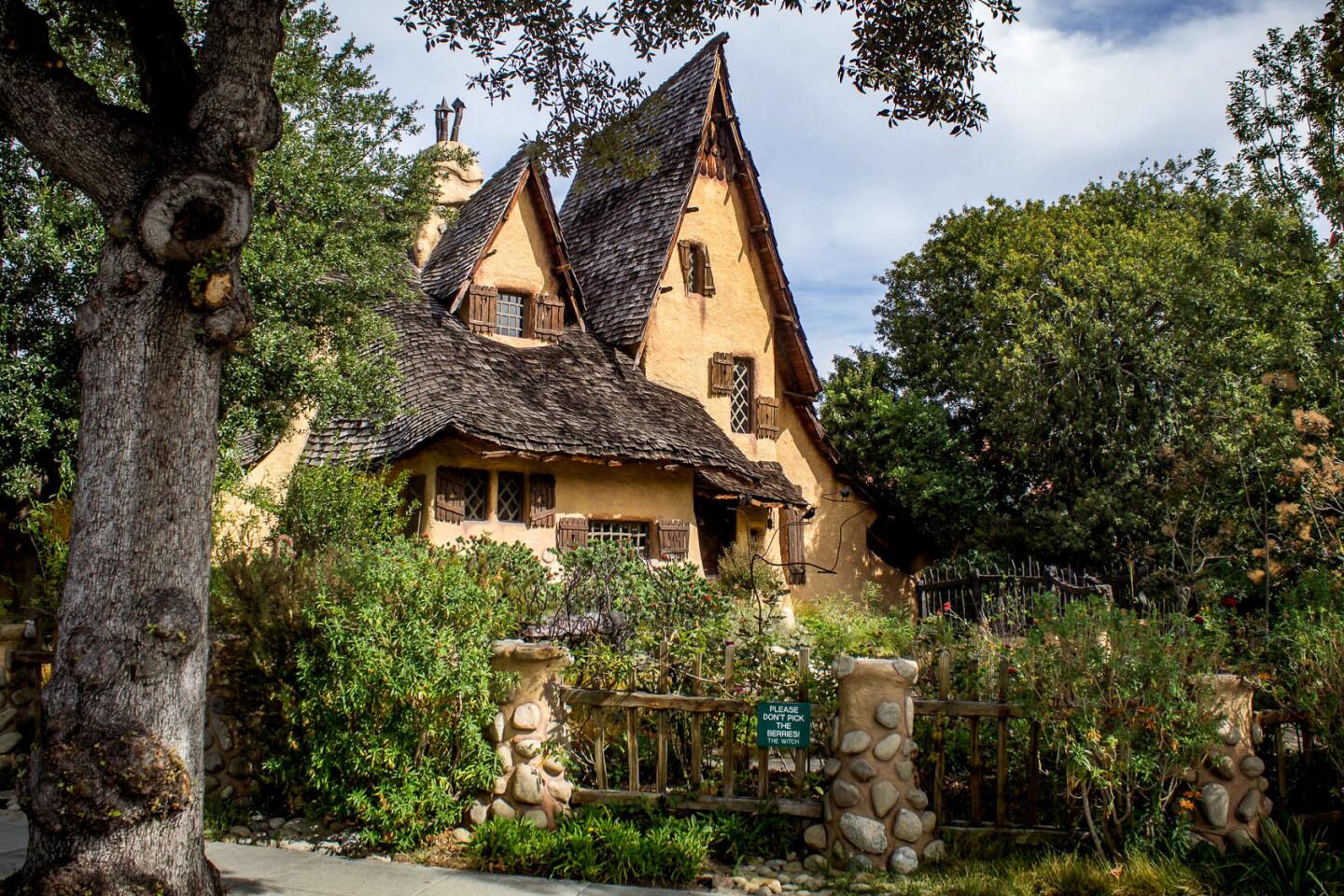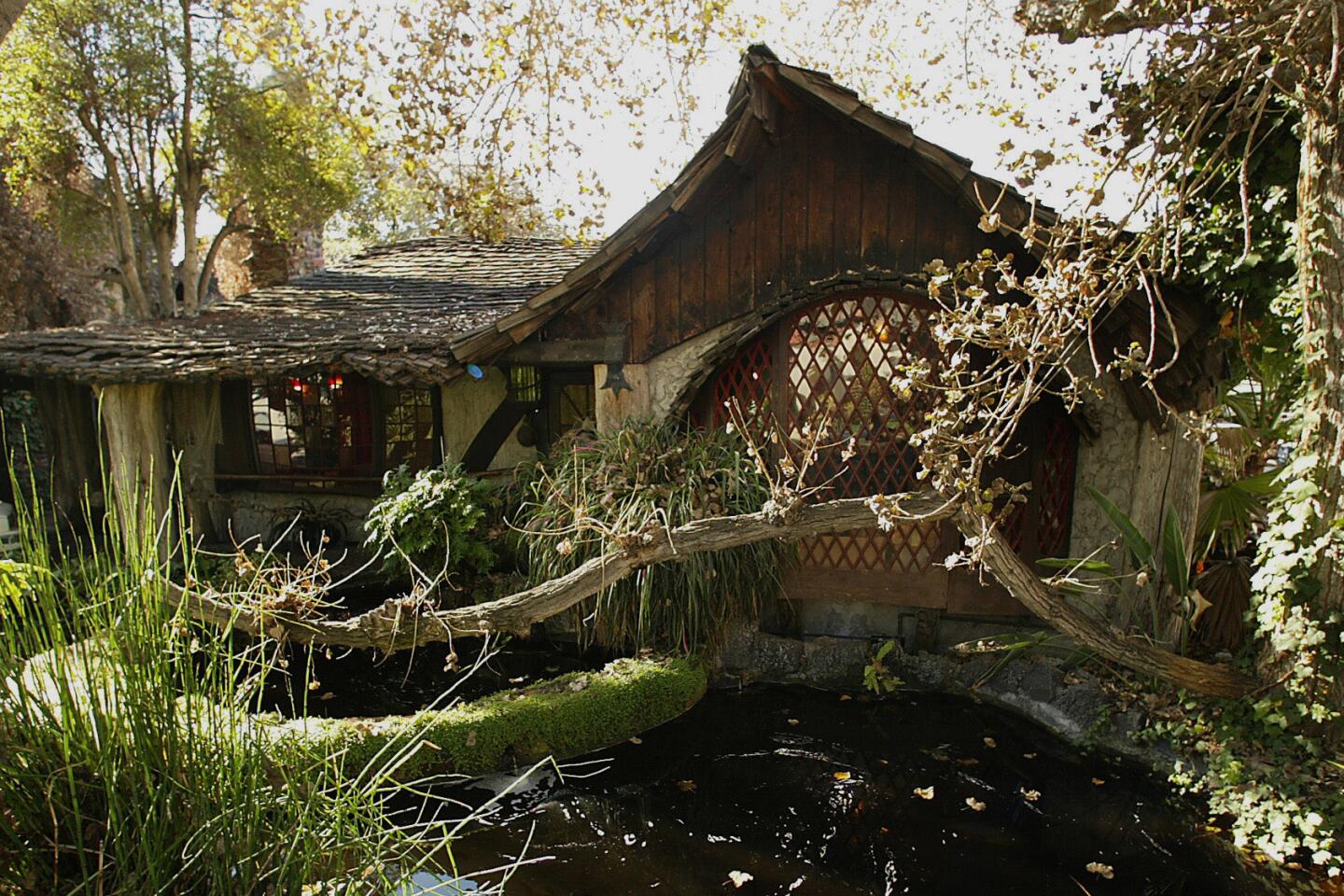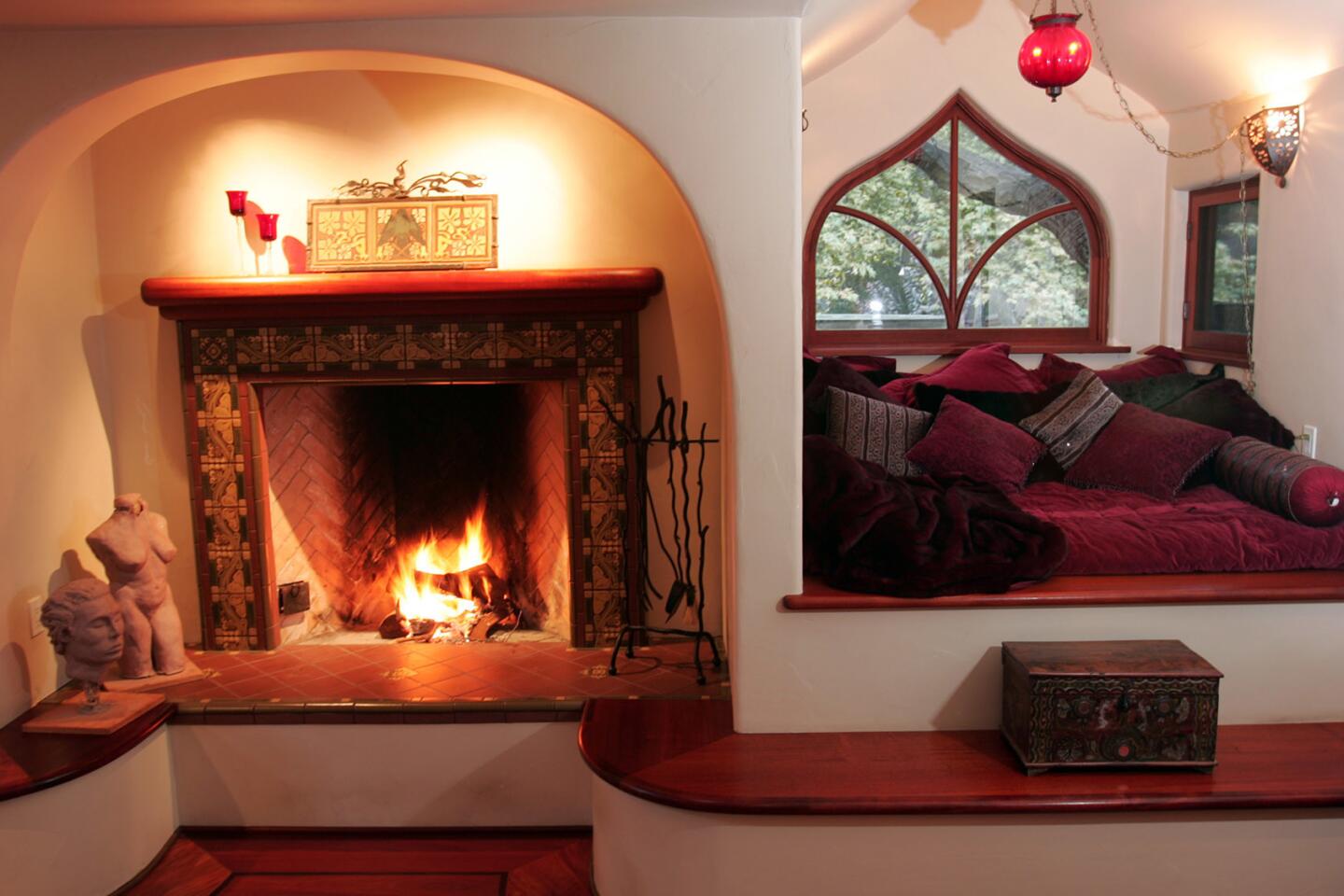Architecture Spotlight: Storybook homes sprang from Hollywood’s imagination
- Share via
With crooked timbers, cockeyed chimneys and details that range from medieval to mirthful, Storybook Style houses seem less like actual homes than Hollywood sets. As it turns out, that’s where their story begins.
In 1921, Harry Oliver was art director at Willat Studios in Culver City when he designed a house with tall, teetering gables and wonky windows, intended as both office space and a backdrop for silent movies. The wavy, sagging roof looked worn from centuries of age, or being sat upon by a giant. It was dubbed the “Witch’s House.”
Producer-director Ward Lascelle bought it for his residence and moved it to Beverly Hills in 1924, according to that city’s planning department. It’s been there ever since, looking like Hansel and Gretel wait just inside.
“You have to have a sense of childlike wonderment about you to connect with a Storybook home,” said Michael Libow, a Beverly Hills real-estate agent who’s owned the Witch’s House since 1998. “It’s fantasy. It’s a bit of a surreal look — like being in a hallucination without the substances.”
The 1920s were the era of Period Revival, which spawned homes echoing English Tudor, French Norman, Gothic and Mediterranean styles. Doughboys returning from World War I, charmed by medieval villages over there, wanted to import the look. Magazine photography helped stateside readers copy Old World architecture. And early Hollywood romanticized the milieu for audiences watching Robin Hood or the Three Musketeers.
Storybook Style took those influences, borrowed the skills of artists and studio set designers adept at mimicking the look of 600-year-old buildings and delivered fantastical dwellings to film stars and other creatives who wanted to crash their real life with make-believe.
“It’s a caricature of a revival style. They’re kind of over-the-top. They’re Hollywood-ized,” said Arrol Gellner, author of “Storybook Style: America’s Whimsical Homes of the Twenties” (Viking Studio, 2001), along with photographer Douglas Keister.
In 1922, Oliver designed the Tam O’Shanter Inn in Atwater Village for friends, a crazy riff on an English Tudor, with timbers he blackened in a furnace.
Other examples began popping up. In 1923, Charlie Chaplin built a small clutch of Storybook cottages on Formosa Avenue in Los Angeles to house actors and crew from his studio.
Hollywoodland, the housing tract begun in 1923 beneath its now-abridged beacon, the Hollywood sign, required Period Revival architecture. So some Storybook homes appeared, including one with a mock drawbridge where Humphrey Bogart lived in the early ‘30s.
Gellner said a common thread was whimsy, “just a sense that people were having fun designing these buildings.” But not most serious architects: “They did not go for this at all. In fact, they ridiculed it.”
Nevertheless, now is the time when everyone is a fan — after all, the Storybook cottages come dressed for Halloween year-round.
Libow, after buying the Witch’s House, said he tried to sit out one Halloween, out of respect for neighbors. But the trick-or-treaters still mobbed his place; he estimates he gets 4,000 visitors in four hours.
“I spend more money on candy than anybody has a right to,” he joked.
Karen Highberger, an interior designer who lives in a 1928 Storybook Tudor in Long Beach, said her house is perfect for the holiday.
“For years we did the whole haunted-house thing, with a smoke machine and a graveyard,” as well as a full-size skeleton and scary music, she said.
Highberger said she and her husband eyed their Storybook for six years before it became available. It required many months of rehab, but now they revel in “its own wacky character,” like the porte-cochère held up by tree trunks.
Libow bought his Storybook only after promising the seller he wouldn’t tear it down. Then he spent more than five years restoring the home, also dubbed the Spadena House, after a longtime owner.
“I saw it as salvageable. I saw it as interesting and quirky,” he said. “I really liked the vibe of the house and I visualized what could be done with it.”
From Los Angeles, the Storybook fad spread to the San Francisco Bay area by the mid-1920s, then elsewhere across the U.S. — the zany, dilapidated look conveyed via movies or shelter magazines.
But by 1935, in the nadir of the Depression, Americans embraced forward-looking styles such as Art Deco and Streamline Moderne, with an eye toward optimism. “Nobody was interested in medieval-looking stuff,” Gellner said. “It became obsolete in an instant.”
Nowadays, building materials can be had cheaply, while skilled workers are pricey — the opposite equation of the 1920s. That means some labor-intensive Storybooks suffered cheap and tragic remodels over the years. But present-day devotees, like Highberger and Libow, pounce when any examples come available, and care for the little jewels.
“They’re so singular,” Gellner said, owners “seem very aware they have something special.”
Style: Storybook
Features: Wavy roofs, steeply pitched roofs, multiple gables, rolled eaves, parapets, turrets, leaded-glass windows (often diamond-paned), iron hardware, arched doorways, chimneys (sometimes crooked), clinker brick accents, exteriors of stone, brick and/or stucco (usually looking haphazardly applied) and half-timbering, often curved or cockeyed — all of it to convey antiquity and/or whimsy.
Where to find them: Upper Beachwood Canyon (the former Hollywoodland neighborhood), Beverly Hills, Pasadena, Los Feliz, Cheviot Hills, Culver City, Hollywood, Laurel Canyon, Miracle Mile, Carthay Circle, Long Beach
Prominent architects, designers and builders: Harry Oliver, Rufus Buck, Jean-Louis Egasse, William R. Yelland, Carr Jones.
More to Read
Sign up for Essential California
The most important California stories and recommendations in your inbox every morning.
You may occasionally receive promotional content from the Los Angeles Times.









